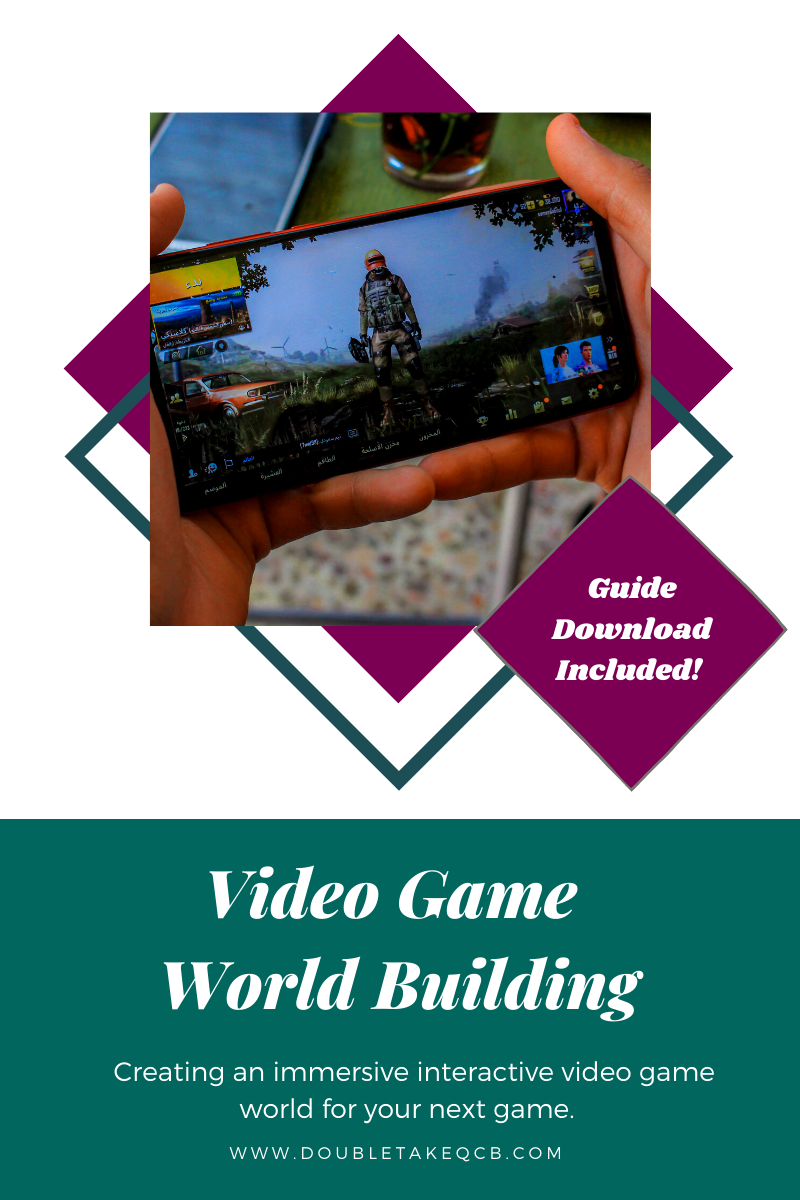
World Building in Video Games
When you play video games, do you notice the world around your character as you play? Of course you do! It’s the base of the whole game, the foundation on which your character and story stand. World building in video games is essential when creating a game just as it is when writing novels.
Note: If you want to delve into writing a story for video games, visit my previous post to find out more! Write a Video Game Story

What is World Building?
World Building can be complex or simple depending on the type of game you are creating. It involves more than the setting, digging deeper into the background, histories, culture, religions and more. Whether you are tweaking the history and world in which we live or creating a whole new system and backgrounds; your job is to take your audience on a journey so compelling and immersive that they forget about the real world for a while and strive to make it to the end. It is essential the foundation of your entire world.
Why is World Building so Important?
When playing a video game, you cannot play it through thought as you would a novel, picturing the way your imagination might create the scene. It’s is a physical world for your character to see, feel, smell, and walk through. As a player plays the game, they are seeing the world as the character perceives it.
As you work, you are literally creating a new world for your character to discover, roam, meet new people. You get to decide everything about this new world for your character: who lives there, the history, culture, societies, flora, fauna, races, religions, conflicts, landscape and so much more. You are embarking on a journey of your own to create this fantastic new world that others will enjoy. This new world allows your audience and players to become emotionally invested in the game world as they travel it, blurring the lines between the game world and real life.
Prep Your World Building Project
Now, this is not necessary, but it may give you some guidance and a resource to refer to when delving deep into your world building. If you are an planner this will definitely come in handy for you. For those of you that like the pantser aspect of planing, it never hurts to got some things down.

Now the idea of this is to just get your ideas on paper first. Jot down some quick thoughts and move on. We’ll delve deeper after you have a rough outline.
Outline:
- Decide on Scope of World – Will your world be an Open world, linear world, or a hybrid of both?
- What is the Genre of Your Game – Knowing this will keep you focused on the types of people, plants, etc are within your world later on.
- History of the World – what events brought your world to the stage it is today. Wars? Famine? Technological downfall?
- Briefly Describe the World
- Types of characters (Human, animal, aliens, etc)
- Animals and insects (If prominent is game, what animals and insects will your character(s) react with)
- Landscapes/Environment
- flora
- fauna
- weather
- more
- Architecture
- Languages
- Resources/items
- Map Ideas
- Magic or no
- Cultures and World Systems
- What different cultures will be present within your game?
- What rules are they to live by? (or rebel against?)
- What is the hierarchy within the cultures and societies?
- Basic Tools
- Weapons
- Food
- Armor
- Items and Collectables List
- List all things that will be collected
- artifacts
- data pieces
- extras
- List all things that will be collected
- Sketch Land/map – doesn’t have to be perfect, remember this is for reference right now.
How To Build a Game World
Now that you’ve gotten your notes, it’s time to really dig deep into the world you are creating. Give each aspect your full attention and provide as much information as you can. Your game will really begin to take shape and you can see it in your mind what it will look like.
Step One: Dive Into the Scope of the World
You should have an idea of how you want your world to be in terms of open world (Horizon Zero Dawn, Assassin’s Creed), linear (Bioshock, Final Fantasy), or a bit of both (Mass Effect, Dragon Age). Other things to think about are how big the game will be and how much your player will get to explore as they play.
Step Two: Develop the World’s Backstory
The backstory of your world will give meaning to everything that you place within it, so this is an essential part of your world building. You are not just roaming the world following the character as they progress through the game, you have their perspective. You are immersed into their world, essentially experiencing what they do emotionally. As the player, you expect the backstory to be revealed as you play the game along with the character.
As you are thinking of the backstory, decide what events and information your character(player) will discover of the worlds history as they play and how that history has affected present day events in the game. Are those events just part of the past or are they still affecting the world today?
Step Three: Create a Culture and System
You may have established some of this when working on your backstory, but it’s important to develop it further. What is the hierarchy within the world? What are rules, laws, and even lore of the land? Other things to consider are religions, societies and other political aspects that should be included. What are their consequences of disobeying those rules and laws? Decide on the inhabitants views of the established systems? What do they believe in? Is there a rebellion? Is it part of the main story?
You can have your game history backstory relate to our own, or completely create a new system for your characters to follow. It’s up to you how you want your character to interact and perceive the culture within your game.
Step Four: Basic Tools
All games have basic tools, weapons, and gear that the character (player) has or gains throughout the game along with any upgrades. These basic tools will depend on the time period your game is placed and the surroundings your character will face. These could include bows, spears, guns of any type, knives, even a branch or dagger depending on where the characters start and their starting experience level. Let’s not forget ammo for those weapons, which could also be upgraded.
Clothes could be scraps of cloth that are upgraded throughout the game allowing for better defense against enemies and food if your characters eat throughout the game (or collect food for other reasons).
When you know what your character is starting with it will be easier to provide upgrades, new weapons, ammo, armor, and more.
Step Five: Items and Collectables
After starting with the basic tools, now it’s the fun part. Now is the time to create the other items and collectables your character (player) will find or use within the world. Will you have letter, artifacts, objects, or some other item or collectable that you wish for your character (the player) to collect.
It would be a good idea to create a spreadsheet to keep track of the types of items and collectables you are going to have within your game, the description, how many or about how many you want within your world. You can even include those that you find within quests, side quests, and other areas of the game.
Note: You may also include the type of creature, monsters, or enemies you’ll face throughout the game.
Step Six: Draw Out the Layout of the Land
This last step for your world building will be to sketch out your land. Whether you have a map available for your player to see or not, drawing out the layout of your world will help with spacial awareness, quest and side quest layout and item/collectable placement.
Things To Keep In Mind When World Building

- Use the five senses as you work through your world.
- Visit Jerry Jenkins Post for some great questions to as when world building!
- Keep all the rules of the world in one place for quick reference
- Keep the end user, your audience in mind as you are creating your world
- Story and Immersion as the player place through the world
- Game specific brands – fictionally branded items to make the game more personal
- Creative currency – Mario has coins, Zelda (link) has Rupees, Ratchet has bolts, Jak and Daxter has orbs, Fallout has bottle caps, sly has coin (but in number 4 those changed to accommodate each historic era), Sonic has rings, etc.
- Other interactive items – mini games within the game (Assassin’s Creed: Black Flag – Nine Men’s Morris (Cowboy Checkers) or Horizon Forbidden West – Strike) or another type of interactive aspect.
Final Thoughts
When looking at the world of video games, it’s imperative that the player be immersed in the interactive storytelling as well as the landscapes that surround them. Even with the game world, players are emotionally invested in what the character does, where they go and how they feel.
Though world building can be difficult and overwhelming, if you take it step by step – one piece at a time, it will make the process go much smoother. Good luck with your building and check out the infographic below to help you along the way!








No Comments
Pingback:
Pingback:
Pingback: